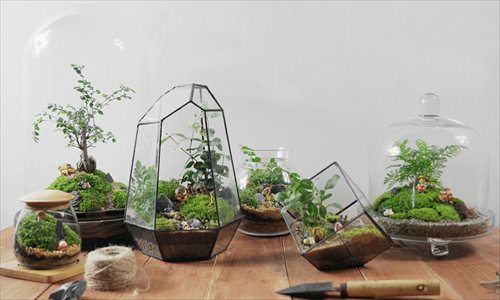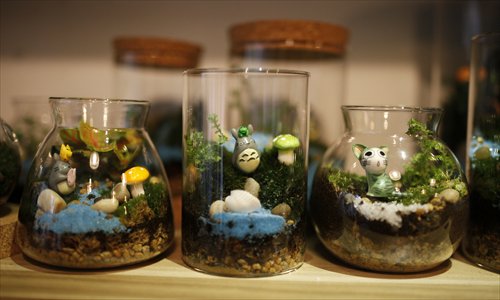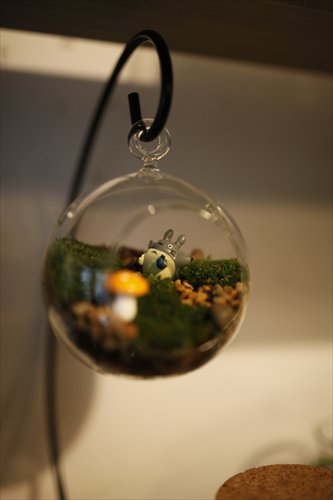Gardening in miniature
Busy urbanites looking to add a touch more greenery to their lives without having to sacrifice time tending to a plant should look no further than a moss terrarium. Not only are they extremely low maintenance, moss terrariums are like a magical little forest that you can bring inside your home or office.
Although moss is hardly a rare sight and plays an inconspicuous role in a garden, it is irresistible when looked at close up. Moss boasts enchanting textures and colors, and is fascinating to observe inside an enclosed glass container.

Moss terrariums at Yuro Photo: Courtesy of Yuro
Wu Ting, the owner of an online moss terrarium store called Yuro, told the Global Times that more and more people are bringing moss terrariums indoors. Their serene, stress-busting presence on a desk or shelf offers a great way to be close to nature when you feel trapped at work, and on a small scale, they can help city dwellers realize their garden dreams.
You can create a tiny garden landscape by putting some moss, a few stones and miniatures into a small glass container. There are no limitations to the design of a moss terrarium; all you need is a touch of imagination.
To make a moss terrarium, you need to first select a glass container. It can be anything from a jar, a soda bottle, or even a light bulb. But it is best to select a container with a lid or a small opening to help lock in the moisture the moss needs.
Next prepare the container with a drainage layer. Place a layer of pebbles or gravel at least a centimeter thick at the bottom of the container. It is essential to have a good drainage system to prevent the plants from sitting in water and becoming diseased.
Wu suggests using lava rocks rather than ordinary pebbles for drainage. Lava rocks are usually bacteria-free and provide acid, which is important as some common varieties of moss such as Leucobryum glaucum grow better in slightly acidic soil.

Plant lovers take part in a hobby group to create moss terrariums. Photos: Cai Xianmin/GT
The second step is to add a very thin layer of dried moss. The dried moss needs to be put in water and soak for a while before it can be used. Squeeze out the excess water, and press the damp dried moss down on top of the pebble layer.
Jin Yanyan, a tutor at Doroq, a gardening studio that provides moss terrarium courses, explains that the dried moss layer functions as a barrier to prevent the soil from falling into the drainage layer. Therefore it is important to cover the pebbles with the dried moss as completely as you can.
After completing the moss barrier, you need to put down a layer of soil. You can get creative at this point by making a little hill or a slope using the soil. You can even add a thicker layer of soil if you want to grow other plants besides moss.
Ying Jiahui, another tutor at Doroq studio, suggests mixing the soil with some activated charcoal to prevent mold and absorb odors.
After the soil is added, pour in a little water to dampen the soil slightly. Be careful not to overwater, and do not let the water level exceed the drainage level.
Now you can put in the moss. Ying suggests tearing the moss into smaller patches to make it easier to fit the moss through the container's small opening. Press down on the moss to ensure that it is in tight contact with the soil layer.
Then the fun part begins as you can insert decorations and miniatures as you like. You can also add some stones and twigs to give the terrarium a natural touch and help to increase humidity.

Moss terrariums
Last but not least, spray the moss that you just planted. Again, be careful not to add in too much water. Ying suggests absorbing any extra water by pressing on the moss with cotton wool or tissue.
Jin said that an open terrarium needs more care than a terrarium with a lid or a cover. You need to spray an open terrarium once a day except on rainy days, while you only need to spray an enclosed terrarium once every three to four days.
Jin added that if you are away for a trip, you can even leave a closed terrarium unattended for a week and it will survive. But it is recommended that you open the lid for one hour a day to help the plant grow better.
Liu Yuxing, who runs Moss Green studio in Shanghai, told the Global Times that it is not always easy to grow moss indoors because most homes and indoor places do not have the environmental conditions that moss has in nature.

A moss terrarium
Moss grows best when it is left unattended in nature. Liu cautioned that it can harm the local ecological system if you collect too much moss from a park or the wild. She suggests collecting a patch of moss no bigger than the size of your palm if you cannot buy it from a gardening market.
You can also check whether there is moss growing in your flowerpots that could be used in making a terrarium.
After completing a moss terrarium, put it in a bright indoor place without direct sunlight, for example, several meters away from a window, or behind a transparent curtain.